Interested in improving your home's efficiency? Make your home Green and give it a Deep Energy Retrofit!
Find out more about Deep Energy Retrofits in Elizabeth's article on ArchiPalooza.com. Click here for details
Interested in improving your home's efficiency? Make your home Green and give it a Deep Energy Retrofit!

Find out more about Deep Energy Retrofits in Elizabeth's article on ArchiPalooza.com. Click here for details
We are thrilled to announce that our Taft Faculty House project has received 3rd Place in the 5th Annual Connecticut Zero Energy Challenge (ZEC). The Taft Faculty House, located in Watertown, CT is a state of the art LEED registered house with a NET Zero, HERS index of (-17). The home is oriented to optimize the use of passive and active solar energy. ZEC homes are the pinnacle of high performance homes and we are so exited to be one of the winners of this prestigious award! Click here to read more about the project.
What is a Deep Energy Retrofit?
DERs are basically a combination plan of attack to improve a home's energy efficiency. We approach DERs from 2 directions:
The envelope of the house refers to the roof, walls, basement(or crawlspace or slab-on-grade), windows and exterior doors . We improve the envelope by...
Trillium Architects is very exited to have one of our home designs in Westport included on the CTGBC Green House House Tour, Saturday June 14th, 12-3. Elizabeth DiSalvo will be at the Westport Farmhouse to answer questions and discuss the benefits of an energy efficient home. Stop by and say hi! For event details and directions, please visit the CTGBC website: http://ctgbc.org/events?eventId=913018&EventViewMode=EventDetails
In November 2014 Trillium Architects will celebrate its 10th anniversary! As a way to mark this milestone, we are taking a fresh approach to many things, including the website, our office space, and ~ most importantly ~ the client experience.
Please have a look at our newly renovated website and keep an eye out for other changes to come!



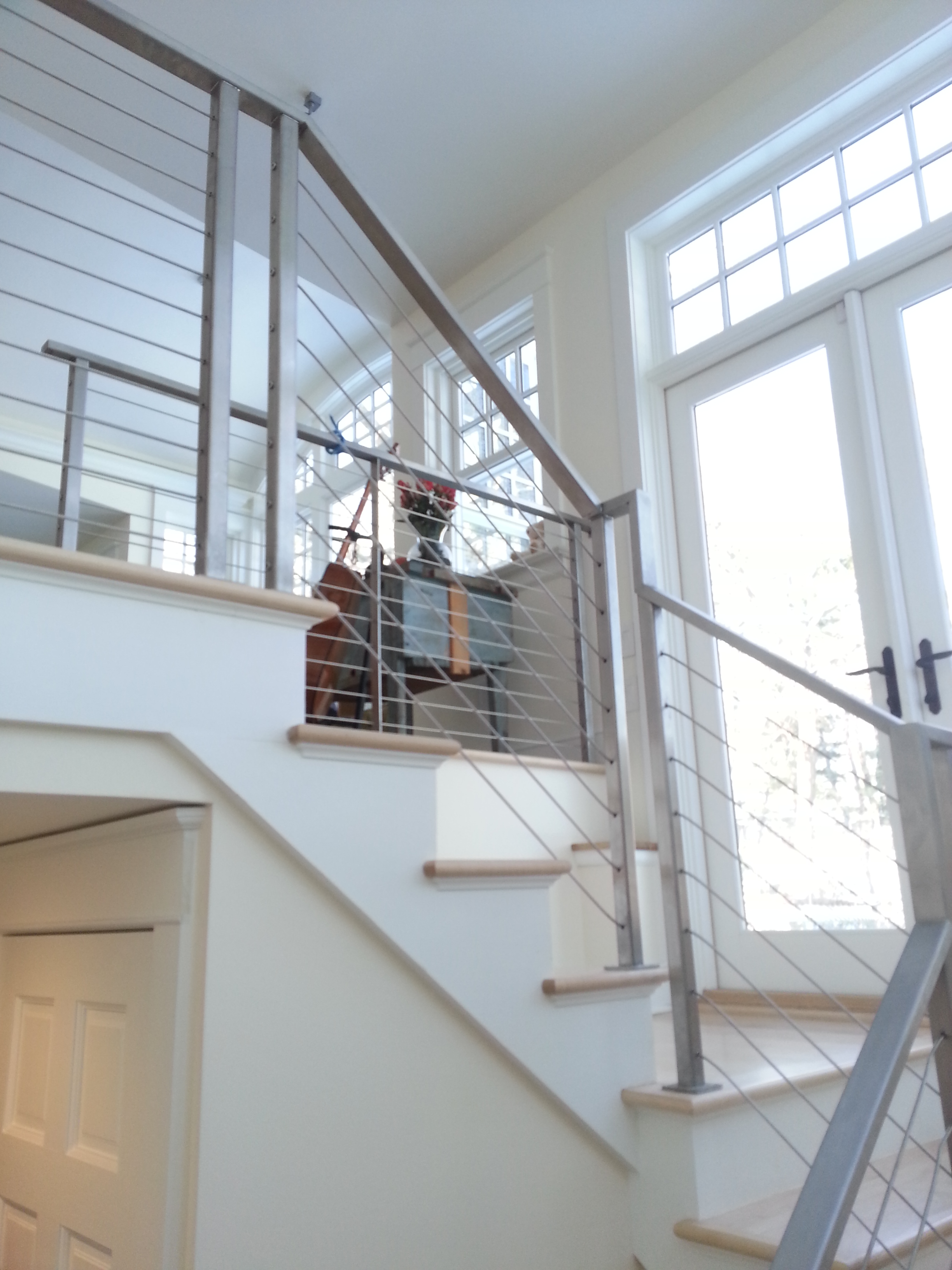

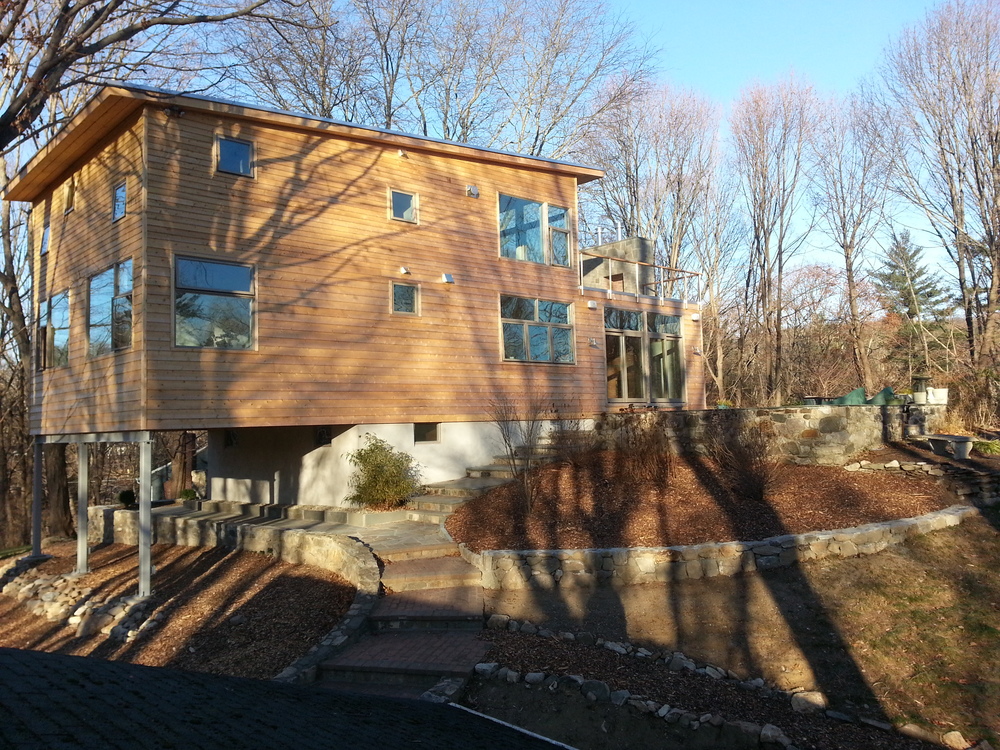
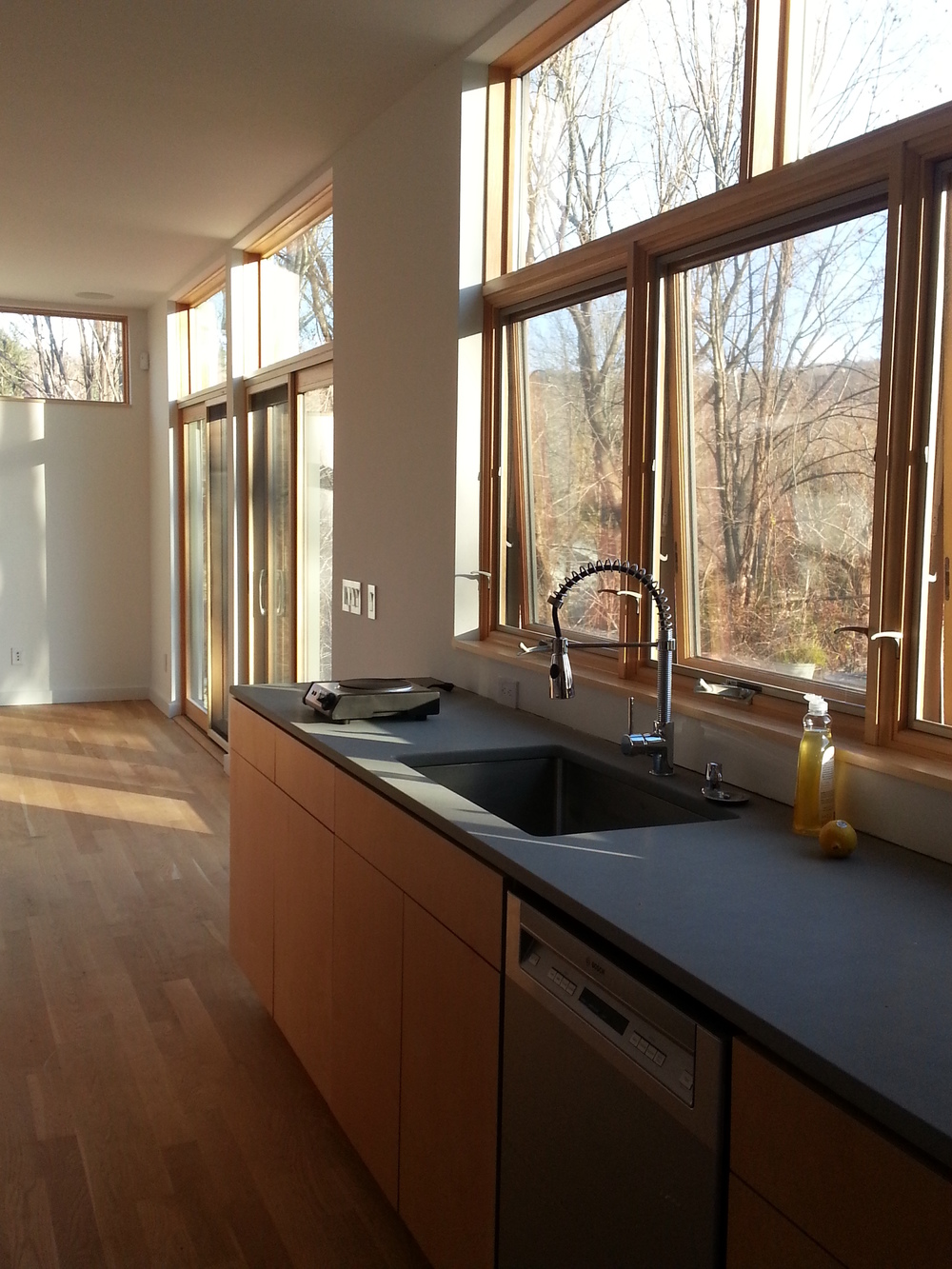
I usually only link straight green building articles to this blog, but this article in the New York Times today just feels too important not to re-post. The Building Industry accounts for approximately 40% of global emissions (manufacturing of materials, delivery, construction, waste and operations).
Making smaller, more efficient buildings, re-using what we can, and creating less waste has never been more important.
HERE IS LINK TO THE NEW YORK TIMES ARTICLE:
http://www.nytimes.com/2013/09/28/science/global-climate-change-report.html?h
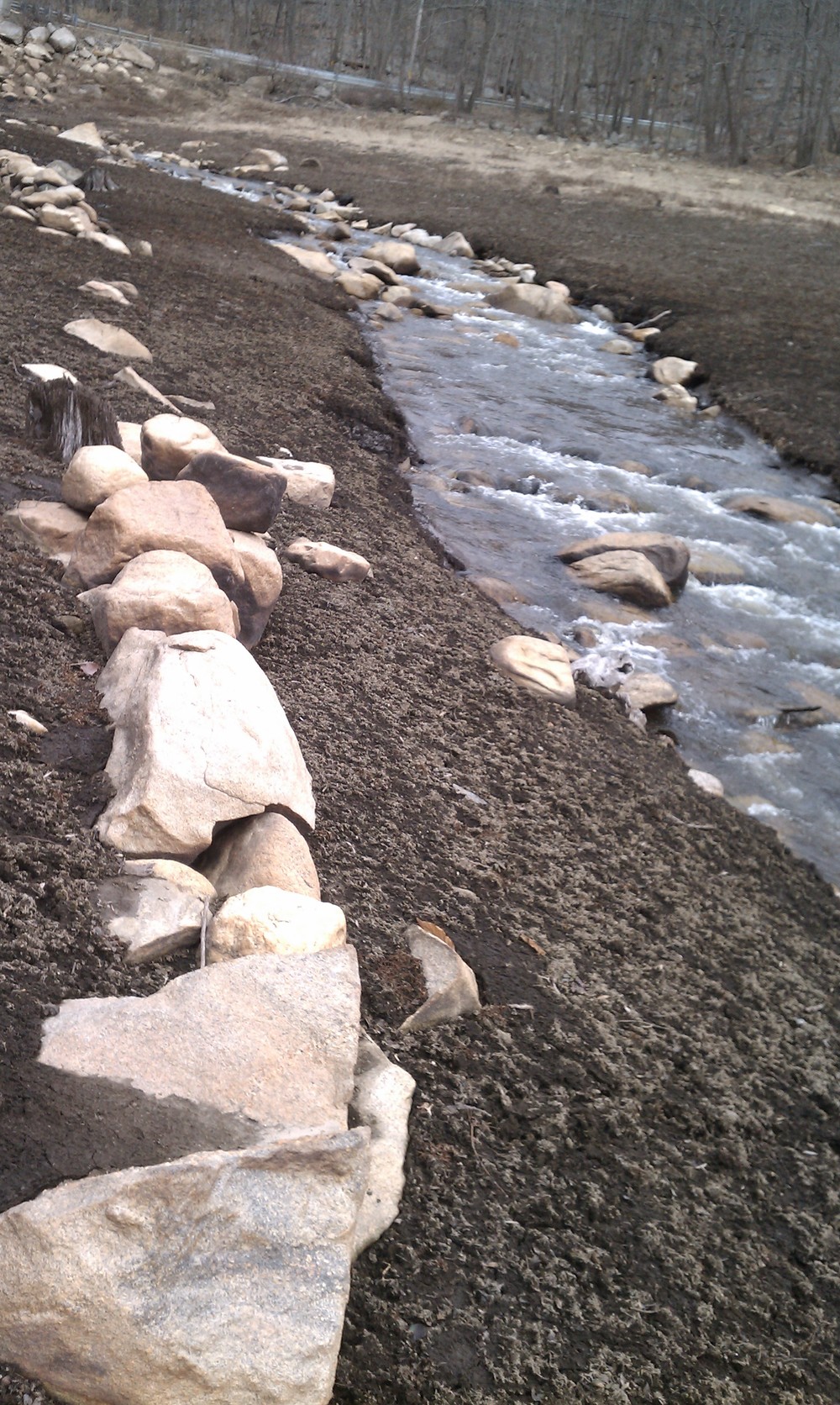 Photo: Elizabeth DiSalvo
Photo: Elizabeth DiSalvo
This kitchen addition in Scardale has been in the works for about 2 years. After a good amount of care and watrering it is growing into a beautiful gem!
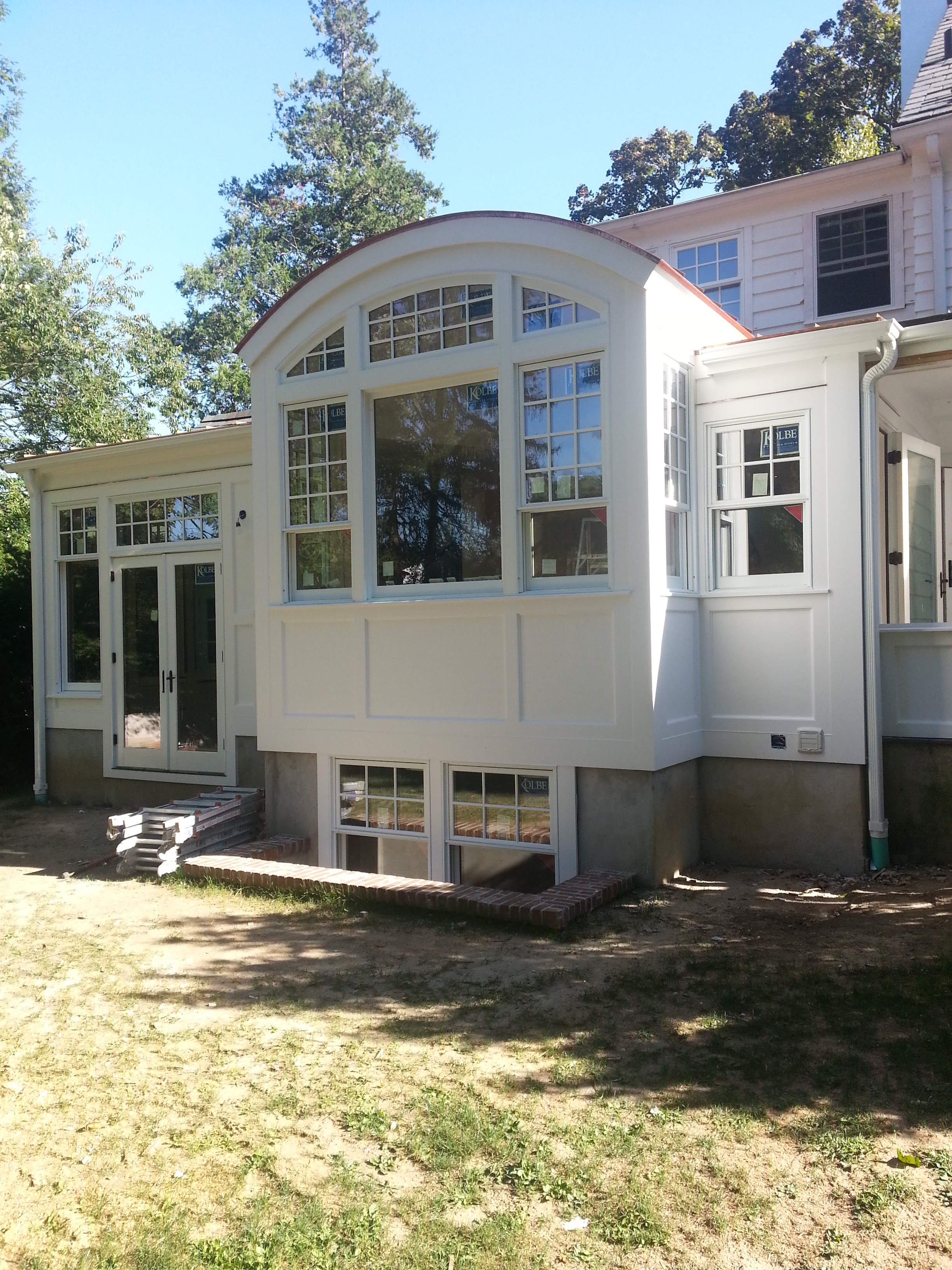
The Kitchen will go in in the next few weeks and finishing touches after that. The clients had a large old Maple from their a relatives yard cut and milled. It will make both the floor and the kitchen center island. Here is a veiw from the kitchen towards the future built in breakfast nook and beyond to the back yard:

The screen porch is a bright and airy retreat:
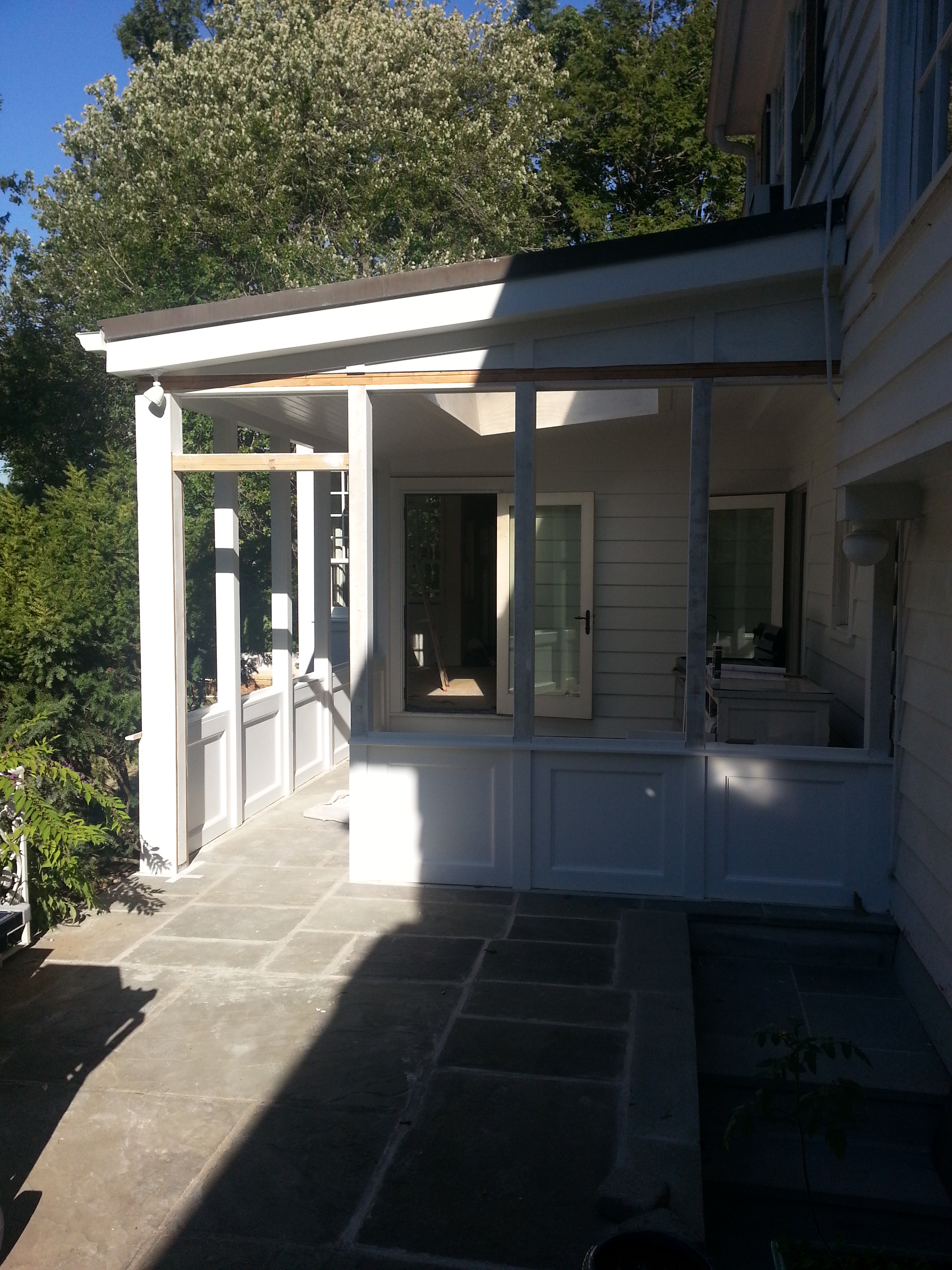
I just want to give a shout out to friends and clients in Virginia who are building an underground house. This amazing and interesting couple with 3 grown children are basically building this house themselves. We helped them with some early design work but basically Kim and Bill are driving this ship.
Imagine the Teletubbies beautiful grass covered dome house, change the shape a bit, add a garage and this is what you get. Click on this link to Kim's Blog to read all about it. Be sure to check back to earlier posts to read all about the hows and why!
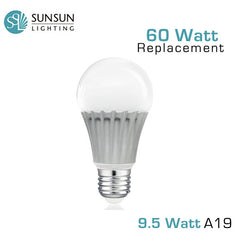
Wow!!! LED 60 watt equivalent bulbs for $9.88! I can't believe it! There really are no excuses after this.
When I first bought this bulb for my family room they cost about $55 each. I was a believer, so I splurged. That was 4.5 years ago and I bought four of them for the most used room in the house. These lights are on 8-12 hours a day... still going strong, no sign of trouble. They save a ton of electricity and are much, much, much more beautiful than those pesky CFL's.
I, for one, have always always hated CFL's. I feel like CFL's were this really bad phase we had to suffer through, like fashion in the 80's. Blech!
Luckily, I went to RPI for undergrad and RPI happens ot have one of the most progressive lighting labs in the world. So I had insider info that better bulbs were coming. SO. I quietly waited while my horrid CFLs took forever to turn on and burned out quicker than they were supposed to and had wretched colors that never matched and basically drove me crazy.
Then, the first realistically priced and nice light quality LEDs appeared. By realistic, I mean less than $100 bucks for a bulb that was to last 15-20 years. It would work out to something like $5/year and that was ok with me. I started changing over. Every year since then the price has been dropping (just like CFL's, just like PV Panels, just like giant TVs, just like computers...)
So, now I say to all of the naysayers! and cheapskates! :
Go get yourself some LED's and BE HAPPY! Yay!
Insulation has been installed in the house on the lake in Ridgefield.
In this house we are using all spray foam insulation. We have been going back and forth with using spray foam over the last 8 years. If works very well but there is always this question about overall health and off gassing. (see below)
We are insulating with a combination of .8lb Open Cell Foam (walls) and 2lb Closed Cell Foam (under the first floor deck and in the cathedral ceiling/ roof.) Closed cell is much more dense, has better vapor barrier qualities and a higher R value but it more expensive and much harder to cut. We put it in places where we really need the vapor barrier.
This house is now basically built like a thermos! The full envelope (walls, roof, floor) are all super insulated and it will take very little energy to heat and cool this house!
Basic stats:
House size: 2,100 sf
Floor: (entire separation of house first floor and crawlspace, basement and cantilevered open air below)
Approx 9" of 2lb Closed Cell Foam (R6/inch)= R 54
Walls: (2x6's at 24" o.c.) 5.5" of .8lb Open Cell Foam (R4.4/inch) = R24.2
Roof: (Flash of 3" Closed cell Foam (R18 Total), filled 6.5" with Open Cell Foam (R28.6 Total)) = R46.6
We are conditioning the space with:
2 Mitsubishi, ducted mini-splits. One per floor.Will provide both cooling and heating.
Back up heat sources:
1 high efficiency gas fireplace insert. This unit will be able to heat most of the house, certainly the 1st floor open floor plan which is approx. 1300 sf. This unit does not depend on electricity and will be placed in the old first floor fireplace. (The foundation and the old brick and stone chimney were the only things left form the original house).
1 direct vent gas fireplace unit in the second floor Master bedroom. 2nd floor is approx 800 sf.
You can see a couple of pictures below of the process. The first shows the walls and ceiling right after the foam has been sprayed in....
1 ERV (Energy Recovery Ventilator)for whole house fresh air and ventilation. Important when you are making such a well sealed, insulated house. But don't forget you are still allowed to open all of your windows when you live in a well insulated house!
Fans We are also installing fans- both room fans and bathroom fans which are low energy use ways to move air around and reduce the use of other heating adn cooling sources during the shoulder seasons.
The first photo (below) shows the open cell foam as it is when first blown in...
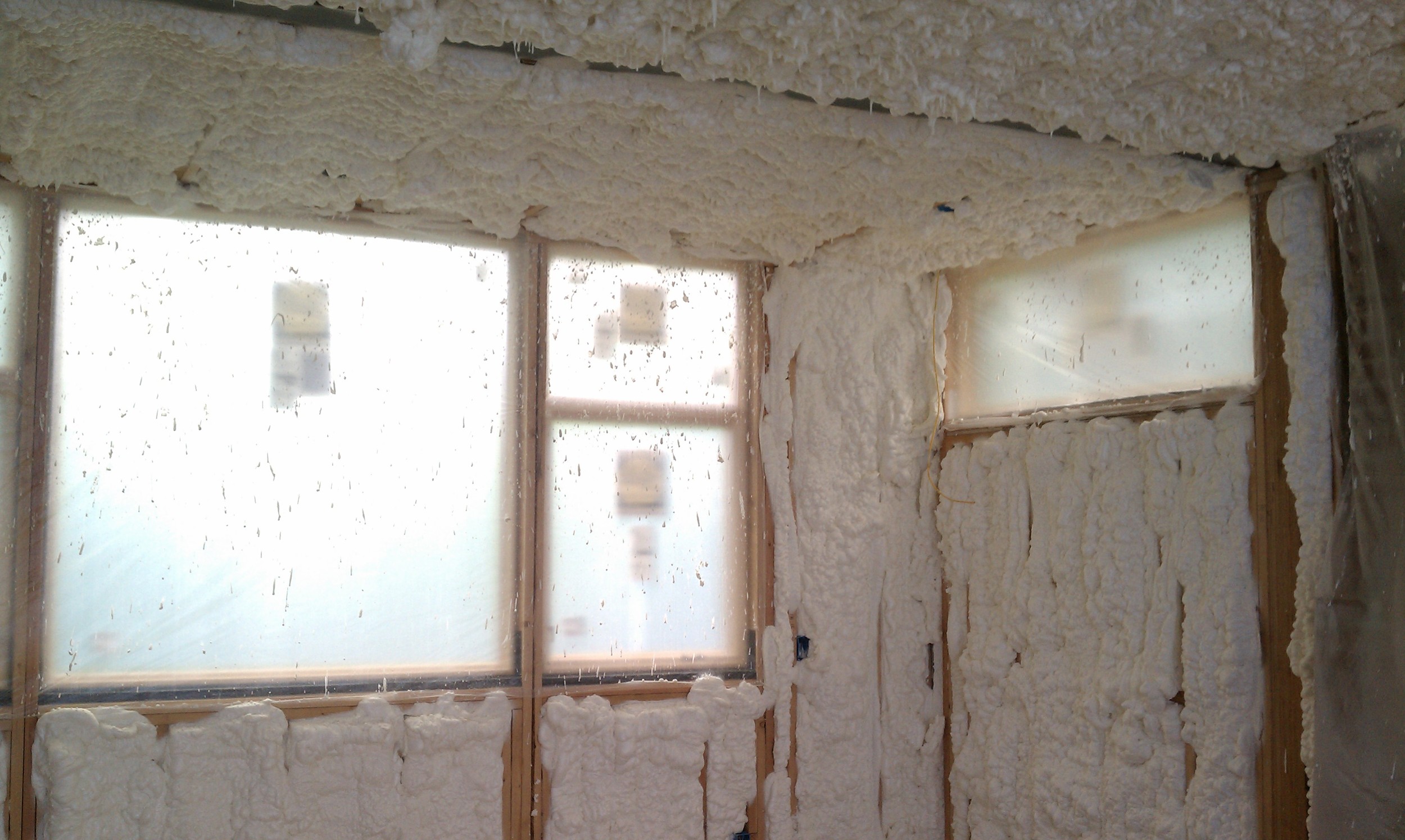
...The second photo shows the foam after walls have been shaved. The shaving allows for the drywall to go in flat while still filling the wall cavity completely. You can also see here how the rim joists (the part above the ceiling along the outer walls of the house) are insulated.
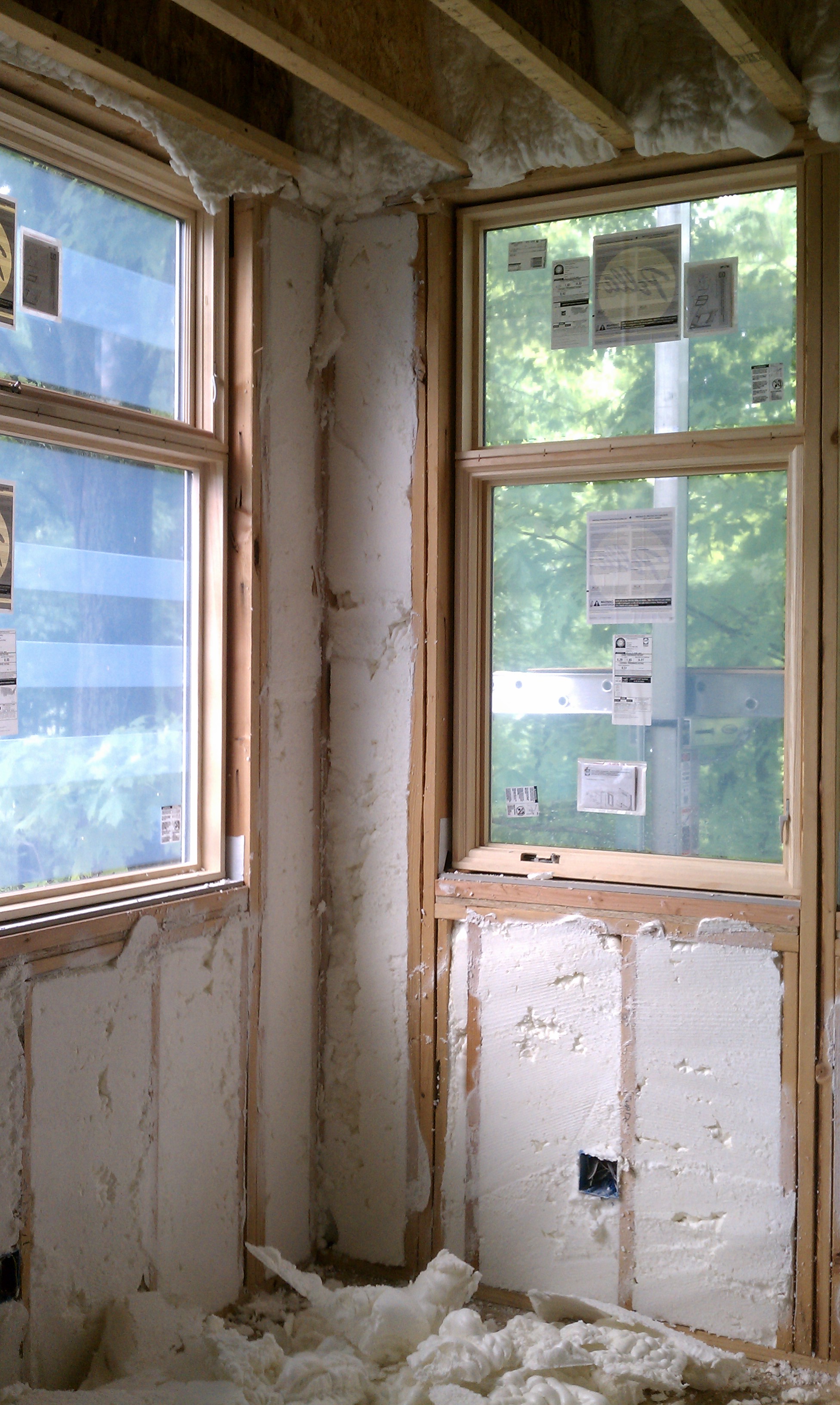
Next step, drywall!
What about Foam?
Yes, Foam DEFINITELY off gasses when it first goes in. You don't really want to be there when it is installed and you can still smell it strongly after the first few days and lightly there after for about 2 weeks. But then you really don't smell it anymore. So is it still offgasing? And if so how badly and how bad is it for you? Does it become inert and therefore basically innocuous? These are all really good questions and the answers are so far pretty debatable.
I feel fairly comfortable with the health concerns once the foam has offgassed to the point of no odor and the drywall goes up and the house is finished. (In most cases it is months between foam insulation going in and the house being finished enough for occupation by the home owners.)
However, one concern is fire. We had clients who had foamed their detached garage and finished it to make it an office a few years back. They had a small garbage can fire that really just scorched the drywall and was put out with little harm done. BUT the office forever after smelled horribly of the burnt foam and know one wanted to go in there anymore. The area of foam had to be fully removed to get rid of the smell.
But foam works so well! and is Very easy to install. It really does have so many benefits.
What are the alternatives? Well, we like cellulose and rock wool and cotton batts and even blown in fiberglass. (Usually all of these are in combination with some sort of rigid house wrapping insulation.)We don't use fiberglass batts as they are pretty ineffectual. (You can read a lot more about insulation in the 'Tech Talk' section of the website.)
Enjoy the warm weather~

Last week I spent the weekend test driving the 2013 Nissan Leaf. I got hooked! It is strange. After driving this amazingly quiet and extremely smooth little car, a few things happened:
#1 All gas fueled cars suddenly appear filthy to me. It is - I am guessing- how people started to see the old coal locomotives after electric ones started to become common. When I drive my old beloved Suburu now I just think 'eeew, gross'.
#2 I started really getting into the game of 'how far can I go on a charge?'. The Leaf monitors your driving style for energy efficiency and lets you know when you are doing well by growing a little tree icon on the dash board display. Cute. I really wanted to grow that little tree. I drove like my foot was on the MOST fragile egg!
#3 I started really paying attention to how many trips I was making to town and back. With a kid and a puppy and poor cooking skills, man I drive back and forth a lot!
Anyway, they convinced me. I am getting my new Leaf tomorrow. It will be this color blue and I am going to put an electric car charging station outside of my office in the center of town (landlord, willing).
I am really excited about this new adventure. The Leaf gets about 100 miles to a charge. A charge takes about 4.5 hours and costs approximately $3.00. I figure I will charge it up about 2 or 3 times a week, lets say 10 times a month. SO that is about $30.00 a month in fuel.
The way the car uses electricity is interesting too. I was expecting a sort of simple correlation between how many miles you can go and how much your battery is charged. Not so. Basically there is a little 'gas guage' on the dash board display and when the car is fully charged it might say '100 miles'. (Meaning you have 100 miles to go before you run out of charge. ) Then as you drive the number on the gas gauge keeps going up and down. Basically if you are powering hard or going up a hill you might buzz through 5 miles on the gauge, but you have only gone 2 or 3 miles on the odometer. (I immediately thought 'what the heck! not cool!'). But then as you drive on and go down hill coasting , or stop at stop signs, you start to get some of those miles back. (There is another fun little display on the dash that shows you when you are using energy and when you are producing energy. Also addictive to watch and challenge yourself with!)
I tested the gas gauge thing over the weekend. After going 45 miles in actual distance, I had used 46 miles on my gas gauge. After going 85 miles of actual distance I had used 83 miles on my gas gauge. Pretty accurate, but it is like the curve of a graph, don't focus on the high and low points, focus on the curve.
What about charging? good question. You CAN charge the car from a normal 110 outlet. Or you can get a car charging station and charge in a third of the time. Basically it takes about 4.5 hours to charge with the 240 volt car charging station. With the 110 outlet it takes a good 12 hours to fully charge. (I tried it at home over night. I plugged it in before dinner and was shocked to see it still charging at 6am when I went out to walk the puppy.) I immediately decided that I am getting 2 car charging stations, one for the house and one for the office. But then I found out how much they cost ! These charger stations can run between $750 and $1400 easily. Yikes. (As usual, Bob was right. Yes Bob I wrote that down.)
I have decided I am going to get one at the office and make it part of the entire Fine Green Homes experience. Any fellow hybrid or electric car user friends out there, come on by and fuel up!


The siding is starting to go up. We are using untreated cedar with a rain screen behind. The house will grey naturally and required basically no exterior maintenance. This picture shows why we will not have solar panels on the house at this point. The low slope roof faces due south, however the clients love the trees. The trees will do an excellent job of shading the house in the summer and when you are inside the house it feels like you are in a tree house! Really nice. So trees won out of over solar power. It is possible that they will be installed at a later date or at another location on site if the right combination of trees fall during the next crazy storm... (hopefully not on the house! Yes, we considered that...)

This is the north-west corner of the house. The old chimney has been repointed and a high efficiency gas insert will be installed in the fireplace opening inside. The stove will be enough to heat most of the house if the power goes out. On the second floor there will be another smaller gas direct vent unit in the master bedroom to take care of any lapses in heat on the second floor. On the roof deck we will install and outdoor fireplace at the chimney- purely for fun. There will be a flat deck and steel cable railings over the gently sloped roof that is on the roof deck now. The roof is sloped to drain. There is a large scupper in each far corner that will draw the water away from the house.


More coming soon!
Come see us this Sunday May 5th at the Wilton Go Green Festival! Wilton has one of the best and most interesting Green Festivals around. It has been well established over the years by a truly dedicated team. We hope to see you there! The weekend promises to be beautiful!
11-4 pm, Sunday May 5th, Town Center, Wilton CT

When Hurricane Sandy slammed into Connecticut late last October, 94 percent of Connecticut Light & Power’s 8,000 customers in the town of Darien lost power. Fifty streets in the coastal community were inaccessible to restoration crews; 20 homes were eventually declared uninhabitable. The power—and with it heat, lights and appliances—stayed off for as long as two weeks. As temperatures dropped, one of the worst storms in the state’s history cast the affluent Fairfield County community into a cold, dark gloom...
Below is an article put out by The Taft School regarding the project we are workign on there!
http://www.taftschool.org/alumni/onephotoleft.aspx?storyname=59north
03/23/2013


I DO!! I have found 3 super cool products this week that I plan to get for my own house.
Here is a bit of info about each:
1. (COOKING + CHARGING) The Biolite Stove http://www.biolitestove.com/
What do you need when you are out of power for a week? Water, heat, a way to cook. Then also nice would be a refrigerator, an electrical source and a hot shower.
Biolite makes both the Camp Stove and the Home Stove that solve two problems- cooking and charging small electronics.. Currently only the Camp Stove is available to the general public. The Home Stove (which is the one I can't wait to get!) is still in testing- mostly in 3rd world countries in need I believe- and is not yet able to be purchased. A good friend of mine who is a leader in the green building movement has the Camp Stove and loves it.

Here is a blurb form the company:
Using our patent-pending technology, BioLite has created a low-cost biomass cook stove that, by converting waste heat into electricity, reduces smoke emissions by up to 95% while simultaneously providing users with the capability to charge mobile phones and LED lights.
2. (WATER) The Bison Hand Pump http://www.bisonpumps.com/
I have been thinking about this for the last year. The water problem is usually solved- in our house- by a giant bathtub filled with water before the power goes. This is not a bad answer and a jacuzzi tub of water can last 4 people for a week of cooking, cleaning and toilet flushing. But WOW! wouldn't be great to just be able to pump that water sitting down there in your well??
These guys have made that a possibility. Here is a blurb from the Bison web site:
We want to emphasize that Bison Deep and Shallow Well Hand Pumps can be installed in the same casing as your existing electric submersible or jet pump in nearly any situation. There seems to be some doubtful conversation out there that this cannot be done. Please give us a call and our sales and technical staff will guide you through your specific installation. As the ol' saying goes "Never say never"!
3. (HEAT) The Wittus Phenix Green Wood Insert http://www.wittus.com/
I love this stove. Here we have an alternative source of heat that is perfect for a blackout situation. It uses wood in a super clean way. It pumps out a lot of btu's very efficiently. It can be ducted to serve more remote parts of a house and it can be controlled by a thermostat. It brings in 100% outside make up air AND it looks great. The Fireplace Insert uses natural convection to disperse the heat and does not rely on a fan. Many of the high efficiency stoves that are installed really need the fan to make the heat fill the space. I appreciate this low tech/ super efficient answer to the heating problem. Plus the fact that it is operates with much lower levels of pollutants makes it a truly acceptable answer to the problem. AND since all have a lot of trees and wood around after the last hurricanes, it seems like a no brainer.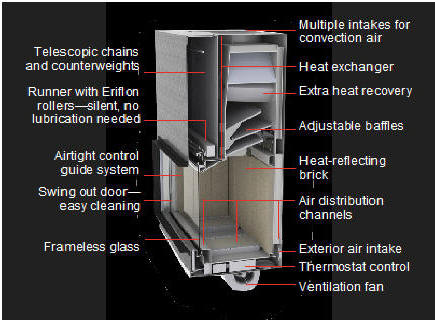
From Wittus:
The Phenix Green zero-clearance built-in fireplaces from Bodart & Gonay of Belgium set a new standard for wood burning stoves. Equipped with the latest retractable door technology, it allows the user to enjoy the fire with the door open or closed.
With the door lifted, you enjoy the warmth of a genuine open fire. With the door closed, you get a full view through the panoramic window and with the maximum efficiency range of 76%—82% and exceptional heating power.
Phenix Green are available in four models: the 75, 85, 95, and the 120. The technological advances along with low CO and particulate emissions makes the Phenix Green fireplace an ecologically friendly product.
All models include these special features:
- multi-ducting capability, which enables heat transfer in up to 6 additional rooms
- a linear, seamless steel frame
- an upward lifting/forward tilting door feature that make it easy to clean the glass viewing window
- the outside air system uses 100% direct air intake
- the thermostat keeps the temperature regulated
- choice of Class A or Heatilator chimney system
- an optional fan capability.